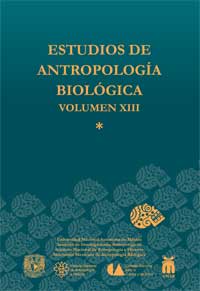Los perros como indicador estacional en los enterramientos humanos prehispánicos. Un caso de estudio en el valle de Zapotitlán, Puebla
DOI:
https://doi.org/10.22201/iia.14055066p.2007.22527Palabras clave:
perros prehispánicos, ciclo reproductivo, sistema de fechamientoResumen
La relación perro-hombre se ha observado desde etapas prehistóricas. En sociedades mesoamericanas del Preclásico, los perros aparecen asociados con entierros humanos, ya sea como acompañantes u ofrenda (Merino y García 1997). El estudio de la fauna en sitios arqueológicos ha demostrado ser de gran utilidad para obtener información en relación con eventos en que las distintas especies animales estuvieron involucradas. En el caso de perros, que poseen un ciclo reproductor relativamente estable, se ha observado que en ejemplares menores de un año de edad es posible emplear un "sistema de fechamiento", ya que estos animales presentan dos periodos de reproducción durante el año (de febrero a marzo y de agosto a septiembre), con dos fases de crianza al año (de mayo a julio y de noviembre a enero) (Blanco et al., manuscrito). Este sistema se aplicó en el material óseo proveniente de un sitio del Preclásico en el valle de Zapotitlán, Puebla, con lo que fue posible proponer la fecha de inhumación (temporada del año) de los restos óseos humanos a partir de la estimación de edad en los cánidos asociados.
Descargas
Descargas
Publicado
Cómo citar
Número
Sección
Licencia

http://creativecommons.org/licenses/by-nc-nd/4.0/

